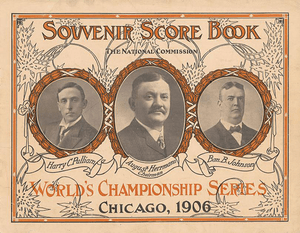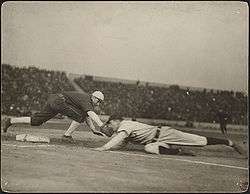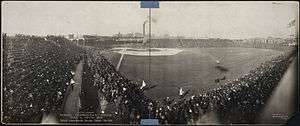1906 World Series
| 1906 World Series | |||||||||||||
|---|---|---|---|---|---|---|---|---|---|---|---|---|---|
 A program featuring league presidents Ban Johnson and Harry Pulliam, and National Baseball Commission President August Herrmann | |||||||||||||
| |||||||||||||
| Dates | October 9–14 | ||||||||||||
| Umpires | Jim Johnstone (NL), Silk O'Loughlin (AL) | ||||||||||||
| Hall of Famers |
White Sox: George Davis, Ed Walsh. Cubs: Mordecai Brown, Frank Chance, Johnny Evers, Joe Tinker. | ||||||||||||
| Broadcast | |||||||||||||
| |||||||||||||

The 1906 World Series featured a crosstown matchup between the Chicago Cubs, who had posted the highest regular-season win total (116) and winning percentage (.763) in the major leagues since the advent of the 154-game season; and the Chicago White Sox. The White Sox, known as the "Hitless Wonders" after finishing with the worst team batting average (.230) in the American League, beat the Cubs in six games for one of the greatest upsets in Series history. This was the first World Series played by two teams from the same metropolitan area.
The teams split the first four games; then the Hitless Wonders (a name coined by sportswriter Charles Dryden) exploded for 26 hits in the last two games. True to their nickname, the White Sox hit only .198 as a team in winning the series but it bettered the .196 average produced by the Cubs.
In Game 3, Ed Walsh struck out 12 Cubs, breaking the previous record of 11 set by Bill Dinneen in 1903.
The 1906 Series was the first to be contested between two teams from the same city. To date, it remains the only World Series contested between the two Chicago teams (In fact, it would be another 102 years before both Chicago teams would even qualify for the playoffs during the same season, as this was next accomplished in 2008), and one of only two Series (the other being the 1944 World Series) played outside New York City that featured two teams from the same city (although the 1989 World Series was played between the San Francisco Giants and the Oakland Athletics, which are roughly 10 miles apart[1]). This is also the most recent World Series where both teams were making their first appearance in the Fall Classic.
Summary
AL Chicago White Sox (4) vs. NL Chicago Cubs (2)
| Game | Date | Score | Location | Time | Attendance |
|---|---|---|---|---|---|
| 1 | October 9 | Chicago White Sox – 2, Chicago Cubs – 1 | West Side Grounds | 1:45 | 12,693[2] |
| 2 | October 10 | Chicago Cubs – 7, Chicago White Sox – 1 | South Side Park (III) | 1:58 | 12,595[3] |
| 3 | October 11 | Chicago White Sox – 3, Chicago Cubs – 0 | West Side Grounds | 2:10 | 13,667[4] |
| 4 | October 12 | Chicago Cubs – 1, Chicago White Sox – 0 | South Side Park (III) | 1:36 | 18,385[5] |
| 5 | October 13 | Chicago White Sox – 8, Chicago Cubs – 6 | West Side Grounds | 2:40 | 23,257[6] |
| 6 | October 14 | Chicago Cubs – 3, Chicago White Sox – 8 | South Side Park (III) | 1:55 | 19,249[7] |
Matchups
Game 1

Tuesday, October 9, 1906, at West Side Grounds in Chicago, Illinois
Cub starter Mordecai "Three-Fingered" Brown was chosen for his dominance against White Sox starter Nick Altrock. Both were perfect through three innings. The Cubs put a runner on second in the bottom of the fourth, but couldn't score. In the top of the fifth, George Rohe tripled to lead off, then scored on an error at home when Patsy Dougherty reached on a fielder's choice. The Sox scored a second run in the top of the sixth. Altrock walked, and was sacrificed to second base by Ed "Noodles" Hahn. Fielder Jones then singled to center but Altrock was thrown out at the plate, Jones taking second on the throw home. He took third on Cub catcher Johnny Kling's passed ball, and Frank Isbell drove him home with a single. The Cubs struck back in their half of the sixth. Kling walked and Brown singled with nobody out. After Solly Hofman sacrificed the runners to second and third, Altrock's wild pitch scored Kling and sent Brown to third, giving him little margin for error with only one out, but he got Jimmy Sheckard to pop out and Frank Schulte to ground out to end the threat. He pitched beautifully for the rest of the game, allowing only one more Cub to reach second, retaining the 2–1 lead for a Game 1 Sox win.
| Team | 1 | 2 | 3 | 4 | 5 | 6 | 7 | 8 | 9 | R | H | E | |||||||||||
|---|---|---|---|---|---|---|---|---|---|---|---|---|---|---|---|---|---|---|---|---|---|---|---|
| Chicago (AL) | 0 | 0 | 0 | 0 | 1 | 1 | 0 | 0 | 0 | 2 | 4 | 1 | |||||||||||
| Chicago (NL) | 0 | 0 | 0 | 0 | 0 | 1 | 0 | 0 | 0 | 1 | 4 | 2 | |||||||||||
| WP: Nick Altrock (1–0) LP: Mordecai Brown (0–1) | |||||||||||||||||||||||
Game 2
Wednesday, October 10, 1906, at South Side Park (III) in Chicago, Illinois
Ed Reulbach was called on for the Cubs to face White Sox hurler Doc White. After matching 1–2–3 first innings, things started to fall apart for White. After cleanup-hitting first baseman Frank Chance led off the top of the second with a strikeout, third baseman Harry Steinfeldt singled to left field and shortstop Joe Tinker beat out a bunt. Cubs second baseman Johnny Evers then reached on a two-base error by White Sox second baseman Frank Isbell, scoring Steinfeldt for an unearned run and moving Tinker and Evers to second and third. Catcher Johnny Kling was then intentionally walked to load the bases and bring up the pitcher, still with only one out. Reulbach squeeze-bunted Tinker home for a second unearned run, moving Evers to third and Kling to second with two out. Solly Hofman followed with an infield single to shortstop Lee Tannehill, scoring Evers for a third unearned run, but when Kling tried to score from second, he was thrown out at home plate, ending the rally. The Cubs added a fourth unearned run in the third, ending Doc White's day on the mound. The Sox scored in the bottom of the fifth inning with an unearned run, thanks to a wild pitch and an error. The Cubs scored three more runs, all earned, in the sixth and eighth to win Game 2 7–1 and tie the Series at one game apiece. Reulbach pitched the first one-hitter in World Series history.
| Team | 1 | 2 | 3 | 4 | 5 | 6 | 7 | 8 | 9 | R | H | E | |||||||||||
|---|---|---|---|---|---|---|---|---|---|---|---|---|---|---|---|---|---|---|---|---|---|---|---|
| Chicago (NL) | 0 | 3 | 1 | 0 | 0 | 1 | 0 | 2 | 0 | 7 | 10 | 2 | |||||||||||
| Chicago (AL) | 0 | 0 | 0 | 0 | 1 | 0 | 0 | 0 | 0 | 1 | 1 | 3 | |||||||||||
| WP: Ed Reulbach (1–0) LP: Doc White (0–1) | |||||||||||||||||||||||
Game 3
Thursday, October 11, 1906, at West Side Grounds in Chicago, Illinois
After allowing two first-inning hits, Sox starter "Big Ed" Walsh didn't give up another and struck out twelve, giving the Sox a 2–1 edge in the series. Third baseman George Rohe cracked a two-out, bases-loaded triple to left in the top of the sixth off Jack Pfiester for the only runs of the game.
| Team | 1 | 2 | 3 | 4 | 5 | 6 | 7 | 8 | 9 | R | H | E | |||||||||||
|---|---|---|---|---|---|---|---|---|---|---|---|---|---|---|---|---|---|---|---|---|---|---|---|
| Chicago (AL) | 0 | 0 | 0 | 0 | 0 | 3 | 0 | 0 | 0 | 3 | 4 | 1 | |||||||||||
| Chicago (NL) | 0 | 0 | 0 | 0 | 0 | 0 | 0 | 0 | 0 | 0 | 2 | 2 | |||||||||||
| WP: Ed Walsh (1–0) LP: Jack Pfiester (0–1) | |||||||||||||||||||||||
Game 4
Friday, October 12, 1906, at South Side Park (III) in Chicago, Illinois
"Three-Fingered" Mordecai Brown pitched 5⅔ innings of no-hit ball for the Cubs before settling for a two-hitter to even the series once more at two games apiece. Nick Altrock was the hard-luck loser, with the only run of the game coming on Johnny Evers' two-out single in the top of the seventh scoring Frank Chance. The Sox put the tying run on second base in the top of the ninth thanks to a two-out walk and a passed ball, but Frank Isbell grounded out to end the threat. The game took just 96 minutes.
| Team | 1 | 2 | 3 | 4 | 5 | 6 | 7 | 8 | 9 | R | H | E | |||||||||||
|---|---|---|---|---|---|---|---|---|---|---|---|---|---|---|---|---|---|---|---|---|---|---|---|
| Chicago (NL) | 0 | 0 | 0 | 0 | 0 | 0 | 1 | 0 | 0 | 1 | 7 | 1 | |||||||||||
| Chicago (AL) | 0 | 0 | 0 | 0 | 0 | 0 | 0 | 0 | 0 | 0 | 2 | 1 | |||||||||||
| WP: Mordecai Brown (1–1) LP: Nick Altrock (1–1) | |||||||||||||||||||||||
Game 5

Saturday, October 13, 1906, at West Side Grounds in Chicago, Illinois
Game 5 was a wild affair with a total of eighteen hits, ten walks, six errors, two hit batsmen, three wild pitches and a steal of home. The Cubs allowed a first inning run to the Sox, then scored three of their own to take an early lead. The Sox tied the game in the third on George Davis' theft of home on the front end of a double steal and then took the lead for good with a four-run rally in the fourth and held on for the victory to take a 3–2 lead in the series. A 12-hit attack led by Frank Isbell's four doubles were enough to overcome six errors committed by the porous Sox defense. "Big" Ed Walsh earned his second win of the series, although he needed three innings of relief help from Doc White.
| Team | 1 | 2 | 3 | 4 | 5 | 6 | 7 | 8 | 9 | R | H | E | |||||||||||
|---|---|---|---|---|---|---|---|---|---|---|---|---|---|---|---|---|---|---|---|---|---|---|---|
| Chicago (AL) | 1 | 0 | 2 | 4 | 0 | 1 | 0 | 0 | 0 | 8 | 12 | 6 | |||||||||||
| Chicago (NL) | 3 | 0 | 0 | 1 | 0 | 2 | 0 | 0 | 0 | 6 | 6 | 0 | |||||||||||
| WP: Ed Walsh (2–0) LP: Jack Pfiester (0–2) Sv: Doc White (1) | |||||||||||||||||||||||
Game 6

Sunday, October 14, 1906, at South Side Park (III) in Chicago, Illinois
Mordecai Brown, pitching on only one day of rest, didn't make it out of the second inning as the Hitless Wonders White Sox stunned the 116–36 Cubs in the Series finale. The Sox battered Brown for seven runs on eight hits while getting a solid pitching performance from Doc White. Although the Cubs scored a run and loaded the bases in the ninth, White got Frank Schulte to ground out for the final out of the series and the White Sox won the World Series over the powerful Cubs, who would compensate by winning the next two World Series from young Ty Cobb, Hugh Jennings and the Detroit Tigers even though they fell far short of 116 wins in 1907 or 1908, for the last Cub World Series wins in over a hundred years.
This game is notable for being the only time the Chicago White Sox have ever clinched a postseason series at home. It remained the only time a Chicago-based team had ever clinched a series at home until the Cubs won the 2015 NLDS on their homefield.
| Team | 1 | 2 | 3 | 4 | 5 | 6 | 7 | 8 | 9 | R | H | E | |||||||||||
|---|---|---|---|---|---|---|---|---|---|---|---|---|---|---|---|---|---|---|---|---|---|---|---|
| Chicago (NL) | 1 | 0 | 0 | 0 | 1 | 0 | 0 | 0 | 1 | 3 | 7 | 0 | |||||||||||
| Chicago (AL) | 3 | 4 | 0 | 0 | 0 | 0 | 0 | 1 | X | 8 | 14 | 3 | |||||||||||
| WP: Doc White (1–1) LP: Mordecai Brown (1–2) | |||||||||||||||||||||||
Composite line score
1906 World Series (4–2): Chicago White Sox (A.L.) over Chicago Cubs (N.L.)
| Team | 1 | 2 | 3 | 4 | 5 | 6 | 7 | 8 | 9 | R | H | E | |||||||||||
|---|---|---|---|---|---|---|---|---|---|---|---|---|---|---|---|---|---|---|---|---|---|---|---|
| Chicago White Sox | 4 | 4 | 2 | 4 | 2 | 5 | 0 | 1 | 0 | 22 | 37 | 15 | |||||||||||
| Chicago Cubs | 4 | 3 | 1 | 1 | 1 | 4 | 1 | 2 | 1 | 18 | 36 | 7 | |||||||||||
| Total attendance: 99,846 Average attendance: 16,641 Winning player's share: $1,875 Losing player's share: $440[8] | |||||||||||||||||||||||
Firsts and lasts

- The 1906 World Series was the first appearance in the World Series for both teams, and the first of three in a row for the Cubs. The White Sox would next reappear in the World Series in 1917.
- The 1906 World Series was the first modern "Subway Series", in a broad sense of the term (Although Chicago did not have a Subway system at the time, plans for the first system began during the series).
- The 1906 World Series is the last World Series, as of 2016, to feature two franchises that had never before appeared in the Series. Also, barring further expansion, the only theoretical matchup that can break this streak would be the Seattle Mariners (representing the American League) versus the Washington Nationals (for the National League).
- The 1906 World Series was the first World Series appearance for the Cubs' famous infield trio of Joe Tinker (shortstop), Johnny Evers (second base), and Frank Chance (first base). The trio hit a combined 9 for 59 in the series.
- Two future Hall of Fame pitchers appeared: Mordecai Brown for the Cubs and Ed Walsh for the White Sox. However, this pair did not pitch against each other in any game of the Series. Nor did either of them pitch the most dominant game of the series. Instead, that honor went to the Cubs' 23-year-old Ed Reulbach, who pitched the first one-hitter in World Series history in Game 2.
- In striking out 12 batters in Game 3, Walsh struck out at least one batter in all nine innings, the first pitcher to do so in a World Series game. Not until Bob Gibson in the 1968 World Series opener would another pitcher accomplish this feat.
- The first five games of the Series were won by the road team. This unusual occurrence was duplicated exactly 90 years later in the 1996 World Series.
- Doc White recorded the first ever World Series save in Game 5. Saves were not officially recognized as a statistic until 1969, but the stat has been retrofitted by historians.
- The 1906 World Series was the first Series with a surprise star, an obscure player who for a brief time became a star. Third baseman George Rohe batted .333 and drove in four runs in the six games of the Series. He had a rather nondescript career prior to and following the 1906 World Series, and was out of the game by 1908.
- Games 1 and 2 were played amid snow flurries in Chicago. This would not happen again in a World Series until 1997.
- Bill O'Neill of the White Sox became the first pinch runner in series history during the sixth inning of Game 3 when he came in to run for Eddie Hahn.
- White Sox outfielder Patsy Dougherty became the first player to both play in and win two World Series. He had previously played for the Boston Americans in the 1903 World Series.
Notes
- ↑ "17 Km - Flight distance between Oakland Coliseum Station and Candlestick Park".
- ↑ "1906 World Series Game 1 – Chicago White Sox vs. Chicago Cubs". Retrosheet. Retrieved September 13, 2009.
- ↑ "1906 World Series Game 2 – Chicago Cubs vs. Chicago White Sox". Retrosheet. Retrieved September 13, 2009.
- ↑ "1906 World Series Game 3 – Chicago White Sox vs. Chicago Cubs". Retrosheet. Retrieved September 13, 2009.
- ↑ "1906 World Series Game 4 – Chicago Cubs vs. Chicago White Sox". Retrosheet. Retrieved September 13, 2009.
- ↑ "1906 World Series Game 5 – Chicago White Sox vs. Chicago Cubs". Retrosheet. Retrieved September 13, 2009.
- ↑ "1906 World Series Game 6 – Chicago Cubs vs. Chicago White Sox". Retrosheet. Retrieved September 13, 2009.
References
External links
| Wikimedia Commons has media related to 1906 World Series. |
- 1906 World Series at WorldSeries.com (MLB.com)
- 1906 World Series at Baseball Almanac
- 1906 World Series at Baseball-Reference.com
- The 1906 Post-Season Games (box scores and play-by-play) at Retrosheet
- History of the World Series - 1906 at The SportingNews. Archived from the original on 2008.